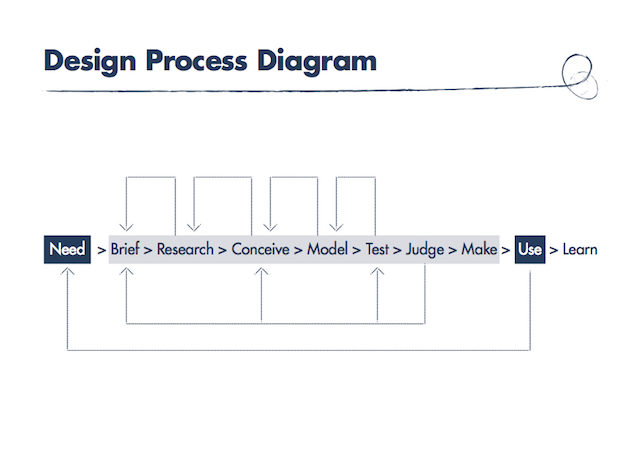In what ways is designing a water network similar to design a bridge, and in what ways are they different? What does a submarine designer have in a common with a software developer, and where do they part company from the vacuum clearner designer? The similiarities and differences between approaches to design in different sectors is the subject of a Royal Academy of Engineering-funded research project that we are working on.
Starting with a meta process
For the last fifteen years the team at Think Up has been developing approaches to teaching design to undergradute engineers, starting with Chris Wise and Ed McCann’s teaching civil engineers at Imperial, then broadening to other sectors of engineering and the built environment.
There are many ways of describing the design process, but the diagram that we use, which has remained largely unchanged in the time that we have been teaching, breaks design down into a series of discrete teachable steps. The diagram captures the iterative nature of the design process, and points to the fact that design is non-determinitistic: the same designers using the same set of inputs might end up with a different answer on a different day.
 Over the years we have found this design process diagram to be a very useful tool for helping undergraduate engineers respond to abstract design challenges; however as Ed remarked in his concluding report as a Royal Academy of Engineering Visiting Professor of Innovation, even with this model in hand, students struggle to develop realistic responses to real engineering design briefs.
Over the years we have found this design process diagram to be a very useful tool for helping undergraduate engineers respond to abstract design challenges; however as Ed remarked in his concluding report as a Royal Academy of Engineering Visiting Professor of Innovation, even with this model in hand, students struggle to develop realistic responses to real engineering design briefs.
It’s important to get it about right
You might think that it is a tall order to expect students to develop the sort of realistic response to a design brief that an engineer with many years’ experience would give. But there are benefits to engineering students getting an answer in the right ball park:
- It is motivating to see that the fruits of your studies can yield something useful
- It helps students become more familiar with right-looking answers, making them potentially better judges of the realism of their designs in future
- It helps build confidence.
But most importantly, the ability to design is an important skill for an engineer, and if a graduate engineer can arrive with the skills to produce roughly right looking answers then they will be of more immediate value to their employer.
How do we help engineering students get closer to the right answer?
Chris Wise and Ed McCann’s experience showed that it wasn’t enough just to teach a meta process for design. In their last year of teaching at UCL they started to recognise that each sector of engineering had its own strategies within that meta process: different starting points; different factors that define the solution space; different factors driving the design. Interviews with senior engineers suggested that for experienced designers these design stratgies were tacit – second-nature approaches that they don’t even need to think about. But to the student, these approaches are not at all initially apparent, and so they struggle to make progress with new design projects.
Investigating domain-specific design stratgies
And so, the aim of the reserach project that Think Up is now kicking-off in earnest in 2017 with the support of the Royal Academy of Engineering is to identify the different key strategies that engineers in different sectors of industry use to design, to synethsise these, and use them to help students as they learn to design.
To carry out this research we are interviewing designers from different engineering sectors and asking them to fill out a questionnarie which helps us to characterise the steps and strategies they adopt.
As we conduct these interviews and identify different strategies, we will be making these available via posts on this site. Once we have gathered a range of strategies we will test them as a teaching tool with students.
How do you design – take the quiz?
We have made the interview questions that we are using public and are encouraging engineers from all sectors and all levels of experience to contribute to help us build a broad picture. If you are an engineer or any other sort of designer for that matter, we’d love to hear how you design.
Fill in the survey here
Related Content
- Post: Having ideas at the IABSE Bath 2017 conference
- Post: How do you design a bridge?
- Post: How to Have Ideas – Workshop Toolbox
- Post: How to have ideas today in Bath
- Post: Strategies of a Consumer Electronics Designer
- Post: Strategies of an Electronic Engineer
- Post: The Strategies of a Circular designer
- Post: What strategies do top engineers from different sectors of industry use in design?
- Event: How to have ideas
